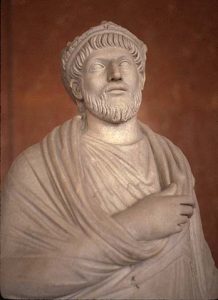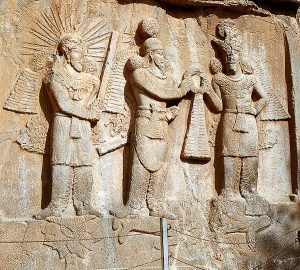
The Roman emperor Constantius II, son of Constantine
Constantine II, Constantius, and Constans
The Roman emperor Constantine died in his 60s in 337 AD. His three surviving sons split the Empire among them, but they soon fought among themselves, and with rebels in Gaul (France). There was a big civil war.
Who was Constantine?
Constantine and Christianity
All our Ancient Rome articles
By 350 AD his son Constantius II was the only one left alive. Like his father, Constantius II was a Christian.
Arian Christianity

The Roman Emperor Julian the Apostate
The Sassanians attack Rome
But with the death of Constantine Shapur II, the ruler of the Sassanids, attacked the Roman Empire again. Constantius needed somebody to lead the army in the East while he dealt with the Germans and the Slavs.
Iron Age in Northern Europe
Who were the Slavs?
Shapur II and the Sassanids
Gallus and Julian
He first chose a cousin of his named Gallus, but Gallus turned out to be both incompetent and cruel, and Constantius soon had him killed. Then Constantius chose Gallus’ younger brother Julian. This time Constantius went to fight the Sassanids, while he sent Julian to fight the Germans.

The Sassanid shah Shapur II hands power over to his general Ardashir II, while both of them trample on the defeated Julian.
The death of Constantius
Julian unexpectedly did a good job fighting the Germans, and his army in Paris raised him to Emperor, standing on the balcony of the Roman fort where the Conciergerie is now. Constantius rushed back to fight Julian, but he died of a heart attack on the way. So in 361 AD, Julian became the Roman Emperor.
Julian and paganism
The first thing Julian did was to announce that he had only been pretending to be a Christian. Actually, he hated Christians. He tried to bring back traditional Roman religion.
More about Roman religion
Neoplatonism
The end of sacrifice
But Julian’s ideas about religion were not the usual ones, and the whole thing made him unpopular. By 363 AD Julian was killed (maybe by one of his own men) while he was fighting the Sassanids in the East.
More about Shapur II and the Sassanians
Christianity and Arianism
Go on to Jovian and Theodosius
Bibliography and further reading about Diocletian and Constantine and their successors:
The Roman Empire, by Don Nardo (1994). For middle schoolers and high schoolers – from Augustus to the fall of Rome.
Diocletian and the Roman Recovery, by Stephen Williams (1985). Gives Diocletian more credit for the recovery than I would, but there aren’t any other biographies of Diocletian in English.
Constantine, by Nancy Zinsser Walworth (1989). A biography for kids.
Constantine and the Conversion of Europe, by A. H. M. Jones (1948, reprinted 1979). Still the best account of how Constantine came to convert to Christianity, and of his relationship with the Church throughout his reign. It’s not specifically for kids, but high schoolers could read it.
The Life and Times of Constantine the Great: The First Christian Emperor, by D. G. Kousoulas (2nd edition 2003). A biography of Constantine.
Julian the Apostate, by G. W. Bowersock (1978). A great biography, and lively reading too!